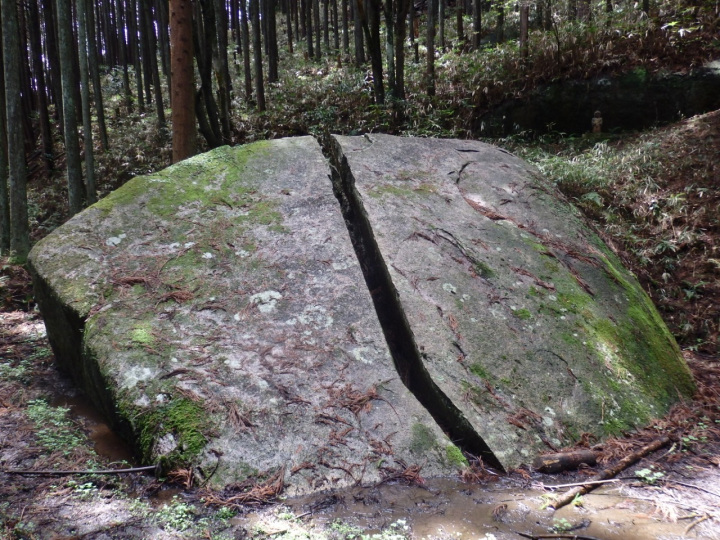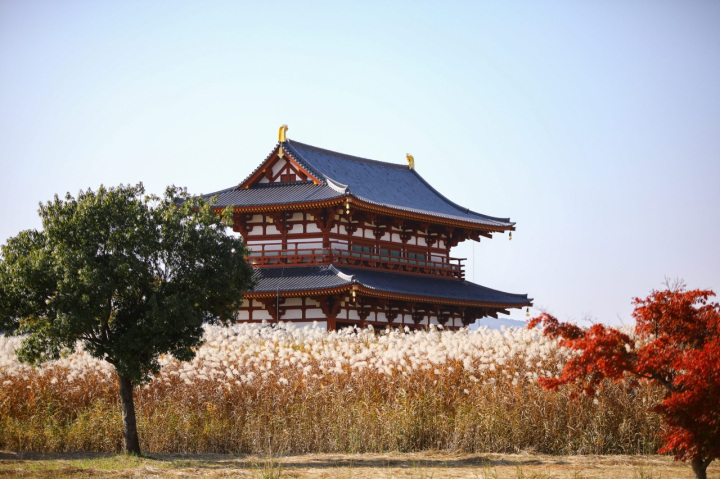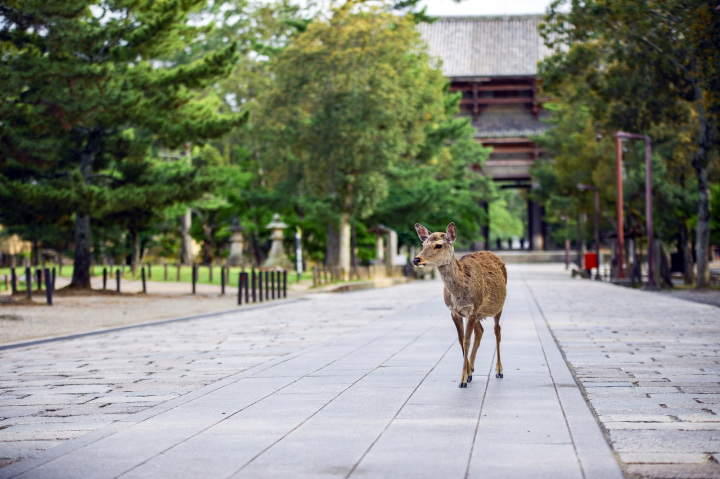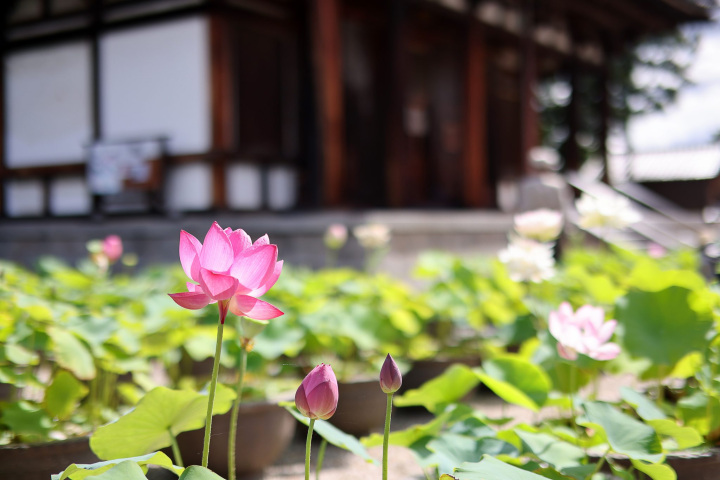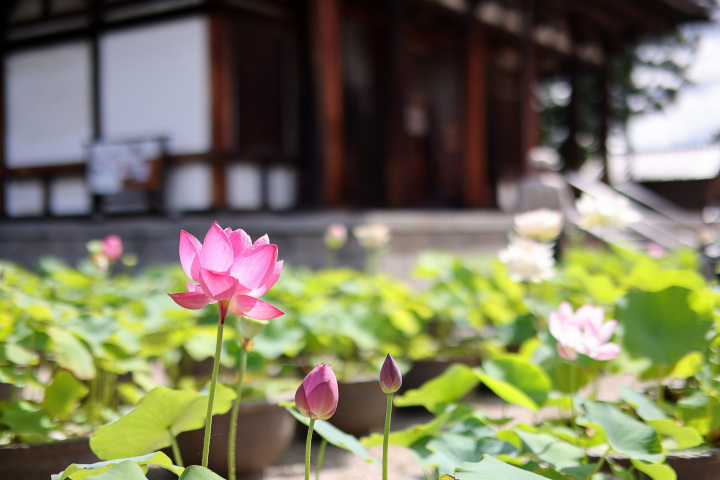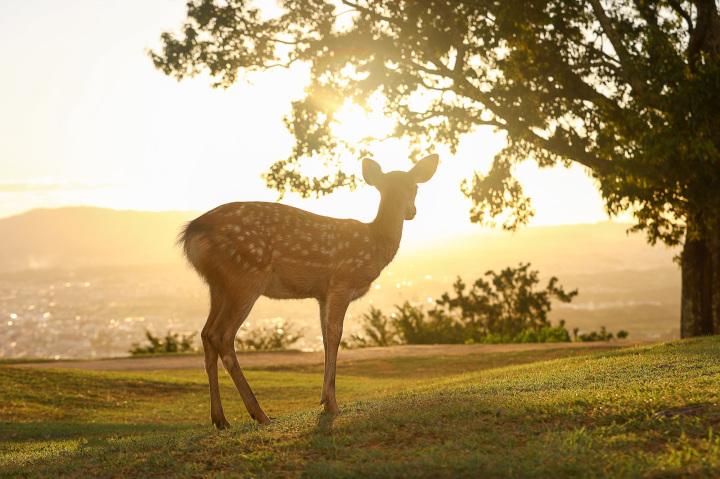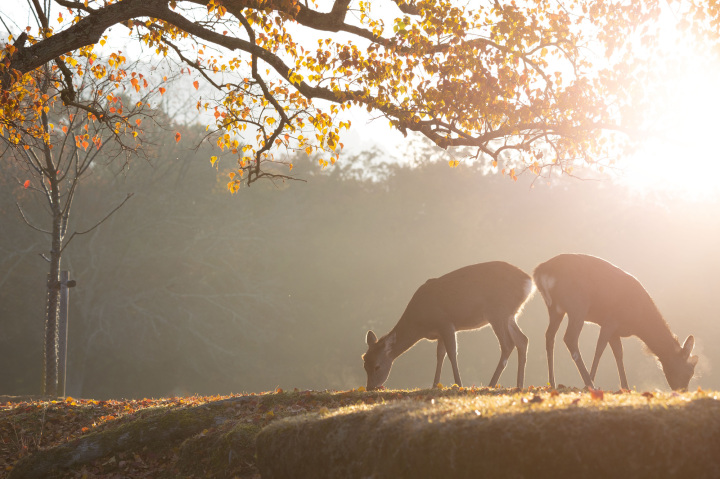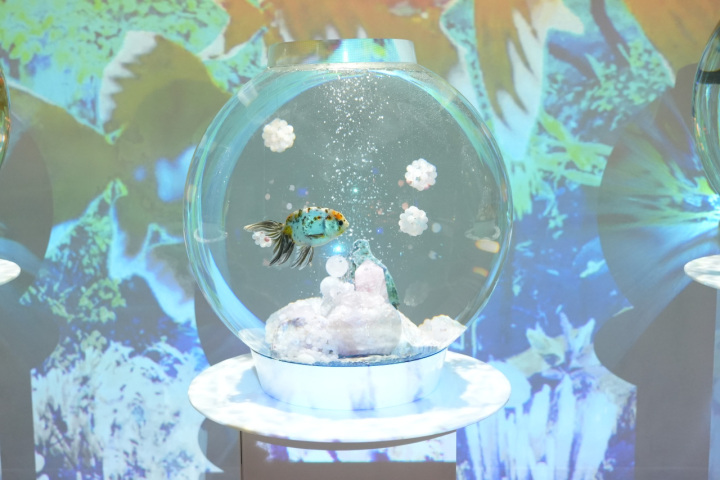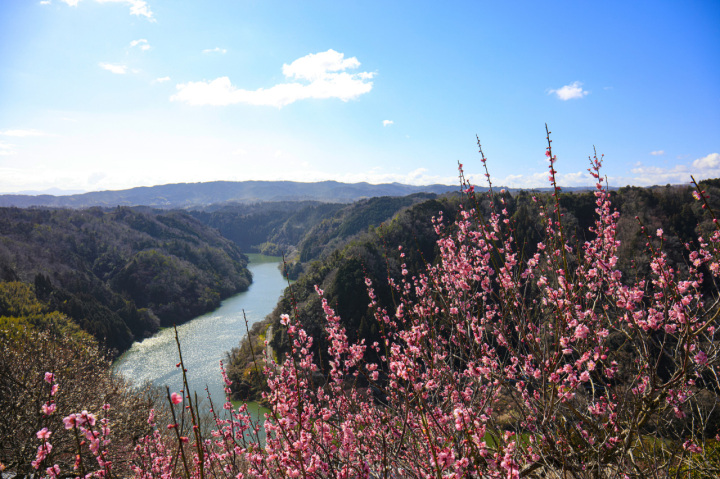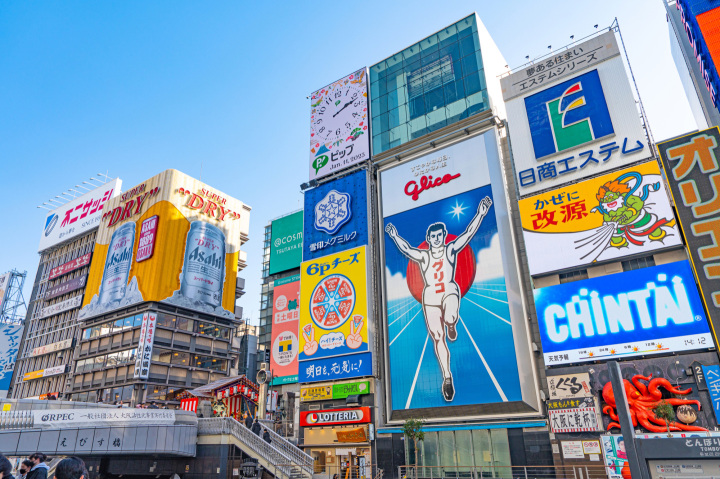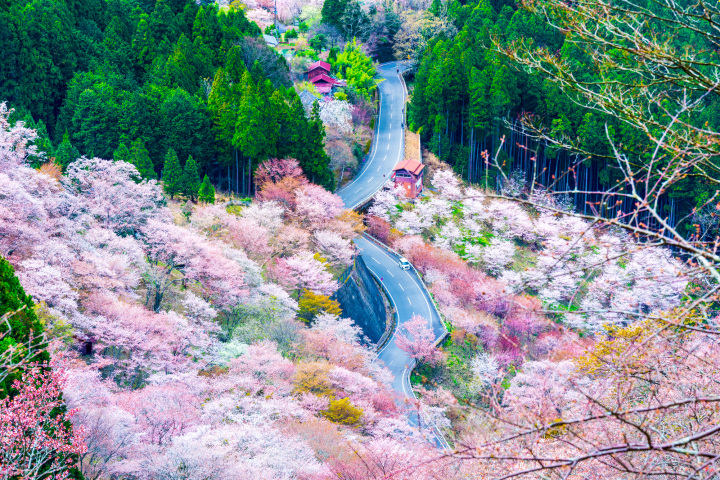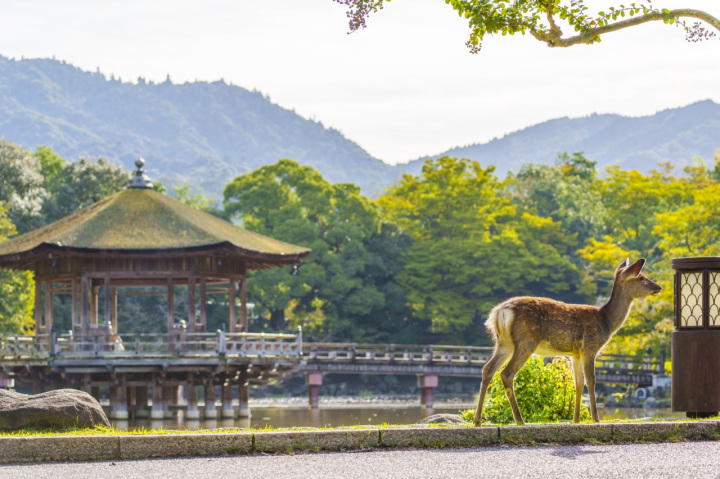Itinerary for 3 days and 2 nights to visit Expo 2025 Osaka, Kansai, Japan and Nara/Kyoto
Expo 2025 Osaka, Kansai, Japan will be held from April 13 to October 13, 2025.When visiting the Expo, you will also want to visit nearby tourist attractions such as Nara and Kyoto. On this page, we will introduce a itinerary to visit Nara and Kyoto starting the day after the Expo. Read this and make a trip to Nara in conjunction with the Expo!
- Days required
- 3 days and 2 nights
- Main methods of transportation
- Train, bus, walking
Itinerary features
- The Museum Yamato Bunkakan
- Nakano Museum of Art
- [Lunch] Around Nishinokyo Station
- Yakushi-ji Temple
- Toshodai-ji Temple
- Nara Palace Site Historical Park
- [Accommodations]Hotels around Sarusawa Pond
- Todaiji Temple
- Yagyu Village
- Yanagi forest
- Former Residence of the Yagyu Clan's Chief Retainer
- Mt.Marishiten
- Yagyu Yasaka shrine
- The Haita Jizo
- Former Yagyu Domain Government Office&Lord's Residence Site
- Image of reclining Amidanyorai statue
- Nakamura roku(six) Jizo
- Housou Jizo
- Amanoiwatate Shrine
- Itto-seki Split Boulder
- Masakizaka Kenzen Dojo
- Houtoku-ji temple
- The graveyard for Yagyu family
- Momiji(maple) Bridge
- Nara National Museum
- Tobihino
- Rokuen
- SHIKA SARU KITSUNE BUILDING
- Kohfuku-ji Temple
- Nara Craft Museum
- Strolling in Naramachi
- Byodoin Temple

The Museum Yamato Bunkakan
Museum surrounded by a naturally rich cultural garden
![[ Undefined: coursed-title-plain ]](/lsc/upfile/courseDetail/0000/0199/199_1_l.jpg)
Yamato Bunkakan is an art museum located in a quiet residential area in Gakuenmae, Nara City. It opened in 1960 to commemorate the 50th anniversary of the founding of Kintetsu.
The museum is surrounded by a naturally rich cultural garden overlooking Hiruta Pond. It boasts a valuable collection of over 2,000 pieces of Japanese and Oriental art, including four national treasures and 31 important cultural properties. During cherry blossom season, 10 weeping cherry trees, descendants of the Miharu Takizakura (Fukushima Prefecture), one of Japan's three most famous cherry trees, are planted, and visitors are delighted by the cherry blossoms in full bloom.
- Address
- 1-11-6 Gakuen-minami
- Times
- 10:00~17:00(Last entry 16:00)
- Closed
- Mondays (or the following weekday if Monday is a public holiday), New Year's holidays, and exhibition change periods
Nakano Museum of Art
Sanctuary within the city
![[ Undefined: coursed-title-plain ]](/lsc/upfile/courseDetail/0000/0201/201_1_l.jpg)
The Nakano Museum of Art opened in March 1984, showcasing a collection of modern Japanese and Western paintings that founder Nakano Kanji accumulated over a 25-year period while working in his family's forestry business. The collection reflects Nakano's passion for art and his strong aesthetic sense. Since its opening, the museum has hosted exhibitions that include artist showcases, thematic displays, and permanent exhibits.
As you descend the stairs at the entrance, a beautiful, borrowed landscape greets you beyond the large windows. The building was designed by Hikotani Kuniichi, who also created the Japanese Garden Guest House for the 1970 World Expo. The interior features red cedar from the Yoshino region in Nara, incorporating Japanese design elements that foster a serene atmosphere for appreciating the artworks.
Located on the shores of the lush Kaerumata Pond near Kintetsu Gakuenmae Station in the suburbs of Nara City, the Nakano Museum of Art allows visitors to enjoy the seasonal plants and wild birds. This is a sanctuary within the city. Across the pond from the museum, in a small pine forest, lies the Yamato Bunkakan Museum.
- Address
- Nara City9-946-2, Ayameike-minami
- Times
- 10:00-16:00 (last entry 15:45)
- Closed
- Mondays (next day if Monday is a national holiday)
Other temporary closures
[Lunch] Around Nishinokyo Station
![[ Undefined: coursed-title-plain ]](/lsc/upfile/courseDetail/0000/0203/203_1_l.jpg)
Unlike the bustling Nara Park area, the historic Nishinokyo area has a peaceful atmosphere with private homes and rice paddies. Along the historical ally from Nishinokyo Station to Yakushiji Temple and Toshodaiji Temple, you can enjoy some Japanese soba noodles and other restaurants. The area also has cafes, so enjoying a leisurely lunch is recommended. Two prominent temples in this area (Yakushiji and Toshodaiji) are both Unesco World Heritage sites.
Image: Kintetsu Nishinokyo Station
Yakushi-ji Temple
Established in 680, the unique layout known as Yakushiji-style is also referred to as "Ryugu-zukuri" (Dragon Palace style).
![[ Undefined: coursed-title-plain ]](/lsc/upfile/spot/0001/0007/10007_1_l.jpg)
Yakushiji Temple is a UNESCO World Heritage site. It was established in 680 by Emperor Tenmu as a prayer for the recovery of his empress from illness. When the capital was relocated from Fujiwara-kyo to Nara, it was subsequently moved to its current location in 718. Two three-story pagodas, the Eastern and Western Pagodas, were built around the main hall and lecture hall. The unique layout is known as the Yakushiji-style temple complex, and the magnificent exterior of these main buildings, with their sloped roofs and low floors, is also referred to as "Ryugu-zukuri" (Dragon Palace style).
Unfortunately, repeated fires destroyed most of the buildings, and only the eastern pagoda remains in its original state. The other structures have been rebuilt.
Yakushiji is home to nine national treasures and 26 important cultural properties, and it remains a temple with a strong following of religious practitioners.
After visiting this temple, consider visiting the nearby Toshodaiji Temple.
- Address
- Nara City457, Nshinokyo-cho
- Times
- 9:00 a.m. to 5:00 p.m. (The admission desk will be open until 4:30 p.m.)
- Closed
- Open all year
Toshodai-ji Temple
Founded by the Chinese monk Ganjin, who overcame hardships to come to Japan and spread the correct precepts of Buddhism.
![[ Undefined: coursed-title-plain ]](/lsc/upfile/spot/0001/0008/10008_1_l.jpg)
Toshodaiji Temple, a UNESCO World Heritage Site, was founded in 759 by the Chinese monk Ganjin, who overcame hardships to come to Japan in response to an invitation from Emperor Shomu in order to spread the correct precepts of Buddhism.
After the capital was moved to Kyoto, the temple experienced a period of decline, but it has since been restored several times. The temple complex is beautifully surrounded by greenery, and still conveys the atmosphere of the time of its founding in the Nara period.
Many of the buildings from that time remain, including the Kondo Hall, known for its "Tenpyo roof," the lecture hall, and the treasure hall. The entire temple complex retains its appearance from 1,300 years ago.
- Address
- Nara City13-46 Gojo-cho
- Times
- 8:30 a.m. - 5:00 p.m. (Last entry at 4:30 pm.)
- Closed
- Open all year
Nara Palace Site Historical Park
The ruins of Heijo Palace, the heart of the Heijo-kyo capital.
![[ Undefined: coursed-title-plain ]](/lsc/upfile/spot/0001/0041/10041_2_l.jpg)
The vast field stretching from Kintetsu Saidaiji Station to Shin-Omiya Station is the Heijo Palace Site (World Heritage). Located at the northernmost end of the vast capital of Heijokyo, with a total area of about 120 hectares, it was home to the Imperial Palace and government district. At the time, the government consisted of eight ministries and 100 agencies. The area is said to have been surrounded by earthworks and moats and had 12 gates, three in each direction.
The Nara National Research Institute for Cultural Properties has conducted excavation surveys since 1959. Buildings and ruins such as the Daigokuden and Chodoin, where official ceremonies were held, the Toin Garden, where aristocrats held banquets and ceremonies, the Dairi, where the emperor lived, and the main gate, Suzakumon, have been restored. The entire area has been open to the public since 1998. At Heijokyo Izanaikan Museum, you will discover how the capital was built and how people lived there.
- Address
- Nara CitySaki-cho
- Times
- Opening hours and closing days differ by facility.
For detailed information, please visit the Heijo Palace Site Historical Park official website. - Closed
- Closed days differ by facility.
[Accommodations]Hotels around Sarusawa Pond
![[ Undefined: coursed-title-plain ]](/lsc/upfile/courseDetail/0000/0211/211_1_l.jpg)
You will find a wide variety of restaurants around Sarusawa Pond, where the five-story pagoda of Kofukuji Temple and willows are reflected in the water. In addition to Nara's famous kakinoha sushi and tea porridge, Western cuisine restaurants using local ingredients and dinner at a restaurant in a renovated traditional townhouse are also recommended.
[Image: Sarusawa Pond]
Todaiji Temple
Nara's most famous temple, featuring its principal image, the Vairocana Buddha, is known worldwide as the Great Buddha of Nara.
![[ Undefined: coursed-title-plain ]](/lsc/upfile/spot/0001/0001/10001_1_l.jpg)
Todaiji Temple and its principal image of the Great Buddha, widely known as Daibutu, represent Nara in all its aspects. Daibutsu is housed in an imposing wooden structure that is the largest in the world.
As the imperial ordinance for the construction in 743, the Great Buddha was cast under full state sponsorship and people's cooperation. The consecrating ceremony was held in 752. It took almost 40 years to complete the whole temple complex, including pagodas, halls, and gradually extended areas. Even after the capital moved to Kyoto, the temple enjoyed its prosperity under the protection of successive emperors. However, the two big wars attacked the temple in 1180 and 1567, severely damaging or burning most of it.
However, with tremendous efforts, the temple was restored each time. Many of the current buildings were reconstructed after that. However, a large number of noted Buddhist statues and buildings from the Nara era remain. Todaiji Temple is a Unesco World Heritage site.
A typical sightseeing course is as follows:
the Nandai-mon Gate
the Daibutsu-den Hall
the Belfry
the Shunjo-do Hall
the Sammai-do Hall (Shigatsu-do)
the Hokke-do Hall (Sangatsu-do)
the Kaisan-do Hall
the Nigatsu-do Hall
the Tegai-mon Gate
the Kaidan-in
Even if you quickly complete the whole course, it takes 4 hours. If you don't have much time, it's better to focus on the Daibutsu-den Hall first, then the Nigatsu-do Hall (the Hall for the Shunie ceremony in March), where you can see an incredible sunset in the west.
(15 minutes' walk from Kintetsu Nara Station)
- Address
- Nara City406-1 Zoshichou
- Times
- ■Great Buddha Hall (Daibutsuden)
April to October: 7:30 AM - 5:30 PM
November to March: 8:00 AM - 5:00 PM
■Hokkedo Hall (Sangatsudo) & Kaidando Hall
Open year-round: 8:30 AM - 4:00 PM
■Todaiji Temple Musem
April to October: 9:30 AM - 5:30 PM (last entry at 5:00 PM)
November to March: 9:30 AM - 5:00 PM (last entry at 4:30 PM) - Closed
- Open all year
Yagyu Village
![[ Undefined: coursed-title-plain ]](/lsc/upfile/courseDetail/0000/0687/687_1_l.jpg)
Yagyu Village is located in the eastern part of Nara City. It is the home of the Yagyu clan, famous for being samurai who served as swordsmanship instructors for the Edo Shogunate for generations. It takes about 50 minutes by bus from the city center. Yagyu is a peaceful rural area in the mountains where you can feel the great outdoors and the history that has been passed down.
Yanagi forest
![[ Undefined: coursed-title-plain ]](/lsc/upfile/courseDetail/0000/0218/218_1_l.jpg)
Not far from the Yagyu bus stop, the Yanagi forest is where the name Yagyu comes from. It is said that someone placed a walking stick here, which became a large willow tree, making this a perfect place to start a Yagyu stroll. Let's begin our Yagyu no Sato walk while thinking about the history of this area.
Former Residence of the Yagyu Clan's Chief Retainer
Reflects the appearance of a high-ranking samurai's residence from the late Edo period
![[ Undefined: coursed-title-plain ]](/lsc/upfile/spot/0001/0036/10036_1_l.jpg)
The former residence of Oyamada Shurei, a notable elder retainer who thrived in the rice trading in Osaka and overcame the financial difficulties of the Yagyu Domain at the end of the Edo period. The lord of the Yagyu Domain at that time awarded him this site in recognition of his achievements, and Shurei constructed a magnificent mansion with stone walls.
It still reflects the appearance of a high-ranking samurai's residence from the late Edo period.
It is open to the public as a museum dedicated to Oyamada Shurei and the Yagyu Domain. It is recognized as a designated cultural property of Nara Prefecture. In recent years, the writer Yamaoka Sohachi has owned it. It is also known as the mansion where he conceived the idea for his novel "Spring Slope," which features Yagyu Munenori as the main character.
- Address
- Nara City155-1 Yagyu-cho
- Times
- 9:00 a.m. - 5:00 p.n. (Last entry at 4:30 p.m.)
- Closed
- December 27th - January 4th
Mt.Marishiten
![[ Undefined: coursed-title-plain ]](/lsc/upfile/courseDetail/0000/0222/222_1_l.jpg)
A small hill near the ruins of Yagyu Junior High School. From here, you can see the whole town of Yagyu. It was named after Marishiten, the patron kami of martial arts, who was once enshrined here. A stone relief depicting Marishiten can be seen where the shrine once stood.
Yagyu Yasaka shrine
![[ Undefined: coursed-title-plain ]](/lsc/upfile/courseDetail/0000/0224/224_1_l.jpg)
Formerly called Shionomiya Daimyojin and worshiped as the 4th Hagayama Shrine of Kasugataisha Shrine, 3 years (1654) Yashiro Sofufu is a festival of Yasaka Shrine in Ohocho. The shrine was solicited to create a shrine, and it was changed to Yasaka Shrine. The temple in the precinct is the Noh stage of Amano Ishidate Shrine. Formerly called Yonnomiya Daijin where sacred the fourth buiding of Himegami shrine though,In 1654 Yasaka shrine had been changed from SusanooMikoto.
The Haita Jizo
![[ Undefined: coursed-title-plain ]](/lsc/upfile/courseDetail/0000/0227/227_1_l.jpg)
It is a rare stone Buddha carved into a stone wall. Because of its swollen cheeks, it is called Haita Jizo (Toothache Jizo).
Long ago, a village headman named Saito Jinzo was wealthy and intelligent. The lord of Yagyu at the time was afraid of his talent and framed him for a crime he did not commit and executed him. Jinzo died saying, "I will burn Yagyu to ashes within three years." The domain was on guard, but three years later, on the last night, the government office was burned down and reduced to ashes. The lord regretted his actions and is said to have carved a stone Buddha into a natural stone at the site of the government office as a memorial.
Former Yagyu Domain Government Office&Lord's Residence Site
The Yagyu Lord's residence and government office were located here.
![[ Undefined: coursed-title-plain ]](/lsc/upfile/spot/0001/0091/10091_1_l.jpg)
Jinya is a residence and government office built mainly during the Edo period to govern the territories of the lords of small feudal domains. They are characterized by not having large-scale defensive facilities, such as castles, but rather being specialized for administrative and residential purposes.
It took three years to complete it after Yagyu Munenori, the first lord of the Yagyu Domain, built his family temple, Houtoku-ji, in 1642. Following the abolition of the feudal domain system and the establishment of prefectures at the beginning of the Meiji era (1868), the area became the Yagyu Prefectural Office, but now only the well and stone walls remain.
It has been developed into a historical park and is a well-known cherry blossom spot featuring about 300 Somei-yoshino cherry trees planted in the surrounding area. Every year, the cherry blossoms bloom later than they do in the center of Nara City. During the Yagyu Cherry Blossom Festival, held annually in early April, there are stage events, including thunderous matchlock gun demonstrations, as well as sales of local food, drinks, and specialty products.
- Address
- Nara City339, Yagyu-cho
Image of reclining Amidanyorai statue
![[ Undefined: coursed-title-plain ]](/lsc/upfile/courseDetail/0000/0231/231_1_l.jpg)
This is a reclining statue of Amidanyorai along the Yagyu Kaido (Tokai Nature Trail). It is said to be in the Momoyama period style (just before the Edo era).
Nakamura roku(six) Jizo
![[ Undefined: coursed-title-plain ]](/lsc/upfile/courseDetail/0000/0233/233_1_l.jpg)
As the name shows, the stone is carved with six Jizo statues also along the Yagyu Kaido (Tokai Nature Trail) and is said to have been made in 1501, based on the date inscribed on the statues. It serves as a boundary to prevent misfortune from entering the village of Yagyu.
Housou Jizo
![[ Undefined: coursed-title-plain ]](/lsc/upfile/courseDetail/0000/0235/235_1_l.jpg)
Smallpox Jizo and the monument of virtue.
To the lower right of the Jizo statue is a monument commemorating the forgiveness of four neighboring villages' debts made before 1428. This is the only monument in Japan left by the people and is of great historical value as a debt forgiveness resulting from an uprising.
- Address
- Nara CityYagyu-cho
Amanoiwatate Shrine
![[ Undefined: coursed-title-plain ]](/lsc/upfile/courseDetail/0000/0237/237_1_l.jpg)
It does not have a main hall, but four huge stones are worshipped as sacred objects. It is said to have been the training ground for the Yagyu clan's swordsmanship, and was highly revered by the Yagyu clan.
Itto-seki Split Boulder
The massive rock split in half is a mecca for anime fans
![[ Undefined: coursed-title-plain ]](/lsc/upfile/spot/0001/0118/10118_1_l.jpg)
The legendary massive rock split in half.
When the famous swordsman Yagyu Munenori (also known as Sekishusai, founder of the Yagyu Shinkage-ryu school) encountered a tengu (a long-nosed monster in Japanese folklore) here during his sword training, he struck down the tengu in two with a single stroke of his sword. However, it turned out that only the massive rock, about 7 meters square, split instead of the tengu, which is why the rock was named "Itto-seki" (One-Sword Rock).
Many fans visit the rock to take commemorative photos, as it resembles a split rock featured in a popular Japanese anime.
- Address
- Nara CityYagyu-cho
Masakizaka Kenzen Dojo
Famous one-eyed Yagyu Jubei trained about 10,000 samurai disciples at the beginning of the Edo era.
![[ Undefined: coursed-title-plain ]](/lsc/upfile/spot/0001/0104/10104_1_l.jpg)
Just below Houtoku-ji Temple, the family temple of the Yagyu clan, lies a kendo dojo that carries the name of the Masakizaka dojo. Yagyu Munenori's eldest son, Mitsuyoshi, who is commonly known as Jubei, is said to have trained approximately 10,000 disciples.
This dojo serves both kendo and zazen, aligning with the Yagyu Shinkage-ryu spirit of "Sword and Zen as One." It was established in 1965 through the efforts of Sadayoshi Hashimoto, the head priest of Houtoku-ji Temple at that time.
The dojo was reconstructed using the roof and pillars from the Nara District Court, which were initially located at Ichijo-in Temple, a subtemple of Kohfukuji Temple. The main entrance was moved from the entrance of the Kyoto Shoshidai, the representative agency of the Tokugawa Shogunate in Kyoto and western Japan.
- Address
- Nara CityYagyushimo-cho, Nara 630-1231
Houtoku-ji temple
The family temple of the Yagyu clan is a renowned location for cherry blossoms and autumn leaves, overlooking the village of Yagyu.
![[ Undefined: coursed-title-plain ]](/lsc/upfile/courseDetail/0000/0243/243_1_l.jpg)
Houtoku-ji Temple is the family temple of the Yagyu clan. Yagyu Munenori built it in 1638. It is located on a mountaintop with a panoramic view of Yagyu village. The adjacent historical materials room displays materials related to the Yagyu.
On the north side are the graves of the Yagyu family.
- Address
- Nara City445 Yagyushimo-cho
- Times
- April to October: 9:00 a.m. – 5:00 p.m.
November to March: 9:00 a.m. – 4:00 p.m.
The graveyard for Yagyu family
![[ Undefined: coursed-title-plain ]](/lsc/upfile/courseDetail/0000/0245/245_1_l.jpg)
In the cemetery behind Houtoku-ji Temple, over 80 gravestones of the Yagyu clan, lords of the Yagyu domain, have been lined up for generations.
The sight is breathtaking, and one can feel the weight of the history the Yagyu clan has built in this area.
Momiji(maple) Bridge
![[ Undefined: coursed-title-plain ]](/lsc/upfile/courseDetail/0000/0247/247_1_l.jpg)
This is the highlight of the Yagyu village walking tour. The vermilion-painted bridge on the way back to the Yagyu bus stop from Houtokuji Temple is the Momiji Bridge. As its name suggests, there are many maple trees in the vicinity, and during the fall foliage season, visitors can enjoy the brilliant reflections on the surface of the river.
Nara National Museum
The treasure trove of Buddhist art hosts the "Shosoin Exhibition" every autumn.
![[ Undefined: coursed-title-plain ]](/lsc/upfile/spot/0001/0043/10043_1_l.jpg)
Many masterpieces of Buddhist art, including Buddhist sculptures and paintings, are on display, and the Nara Buddhist Temple has nearly 100 Buddhist statues on permanent display.
The New Building hosts special exhibitions approximately twice a year. Notably, the autumn Shosoin Exhibition draws many fans from across the country.
The Main Building, completed in 1894 and designed by Katayama Tokuma, who also worked on Akasaka Palace (State Guest House), is designated an Important Cultural Property as a representative example of Western-style architecture from the Meiji period.
- Address
- Nara City50 Noborioji-cho, Nara 630-8213
- Times
- 9:30 a.m. - 5:00 p.m. (Last entry at 4:30 p.m.)
*Hours may be extended for special exhibitions and other events. Please check the official website for details. - Closed
- ・Mondays (Or the following day on weeks in which Monday is a public holiday. In cases of consecutive holidays, the museum remains open and closes the day after they end.)
・December 28 - January 1
Tobihino
Vast grassy area of Kasugataisha Shrine where herds of deer playing freely
![[ Undefined: coursed-title-plain ]](/lsc/upfile/courseDetail/0000/0253/253_1_l.jpg)
Tobihino, located on the grounds of Kasugataisha Shrine, is a vast grassy area facing the main sando (approach) to the shrine. In the past, it was also known as Kasugano. It was an ancient place of worship that overlooked Mt. Mikasayama. During the Manyo period (629-759), aristocrats played polo here, and in the Heian period (794-1192), it became a famous recreational spot for picking young leaves and viewing cherry blossoms.
Here, you can see herds of deer playing freely. The Shika Yose (Deer Gathering) event is also held here. It utilizes the musical tones of a natural horn to gather the deer in a specific location.
- Address
- Nara CityKasugano-cho
Rokuen
A cozy protection facility for Nara deer, where you can enjoy events like "Fawn Open House" and "Deer Antler Cutting."
![[ Undefined: coursed-title-plain ]](/lsc/upfile/courseDetail/0000/0255/255_1_l.jpg)
Nara Park is home to approximately 1,300 Nara deer (as of 2024), a designated natural monument of the country.
"Rokuen," the Deer Garden, is a deer protection facility located within Nara Park and operated by the Nara Deer Protection Foundation. It protects approximately 300 deer, including sick or injured ones, and aims to create an environment where people and deer can coexist.
In addition to exhibits, such as panels that educate visitors about deer ecology and history, guests can observe the deer protected in the Rokuen throughout the seasons. This is a place to reflect on and safeguard Nara Park's rich nature and the coexistence of people and deer.
- Address
- Nara City160-1 Kasugano-cho
- Times
- 10:00 AM - 4:00 PM
(Not applicable during special exhibition periods) - Closed
- Mondays (except during special public viewing periods)
Deer antler cutting event (early October)
New Year's holiday (December 29 to January 3)
SHIKA SARU KITSUNE BUILDING
![[ Undefined: coursed-title-plain ]](/lsc/upfile/courseDetail/0000/0257/257_1_l.jpg)
SHIKA SARU KITSUNE BUILDING is a much talked-about facility that opened in 2021 on the site where Nakagawa Masashichi Shoten was founded in Nara and has a history of more than 300 years. Three stores bearing the names of SHIKA(Deer), SARU(Monkey), and KITSUNE(Fox) are housed in the building, and the main store of Nakagawa Masashichi Shoten in Nara handles more than 3,000 handicrafts from all over Japan. The facility also offers activities to experience Nara's crafts, such as hand-weaving, which can be reserved through the official website.
Kohfuku-ji Temple
The prosperity of Nara is deeply linked to the development of this temple.
![[ Undefined: coursed-title-plain ]](/lsc/upfile/spot/0001/0029/10029_1_l.jpg)
The Kohfukuji Temple was one of the seven most prominent temples of the Nara era and a tutelary temple of the Fujiwara clan, the most influential clan in Japanese history. Nara largely owed its prosperity to the temple's development.
In 710, the Fujiwara clan transferred the predecessor of the present Kohfukuji Temple from Asuka to the Nara capital. Then, the temple extended its influence with the Fujiwara family's prosperity even after the capital moved to Kyoto. The war in 1180 burned down most of the temple, however, in later years, Kohfukuji eventually became the practical ruler of Yamato Province (present Nara Pref.) until the 16th century. They were so influential that they repeatedly appealed to the Imperial Court in Kyoto with soldier monks.
The vast precincts of the temple include the Chukon-do Hall, the Tokon-do Hall, the Hokuen-do Hall, the Nan'en-do Hall, the Five-storied Pagoda, the Three-storied Pagoda, and the Treasure Hall, some of which were constructed in and after the 13th century. As for Buddhist sculptures, many famous articles and masterpieces of the Nara era exist. Of these 136 designated national treasures (Buddha statues, etc.) in Japan, 18 are housed at Kohfukuji Temple. The most famous statue is the Asura Statue.
The five-story pagoda is currently undergoing long-term repair work and cannot be seen from the outside.
- Address
- Nara City48 Noborioji-cho
- Times
- open from 9:00 a.m. to 5:00 p.m. (Last entry is at 4:45 p.m.)
- Closed
- Open all year
Nara Craft Museum
Please stop by during your stroll around Naramachi.
![[ Undefined: coursed-title-plain ]](/lsc/upfile/spot/0001/0049/10049_1_l.jpg)
The Nara Crafts Museum aims to promote the traditional crafts and arts of Nara, which have been passed down and refined over the city's long history. In addition to the artworks themselves, the museum exhibits the tools and materials used in their production, with a particular focus on disseminating knowledge about crafts.
The museum is situated in the heart of Naramachi, so be sure to stop by during your stroll.
- Address
- Nara City1-1 Azemame-cho
- Times
- 10:00~18:00(Last entry 17:30)
- Closed
- Mondays (open if the day falls on a national holiday)
Days following a national holiday (except when that day is a Saturday, Sunday, or another national holiday)
New Year's holiday (from December 26th to January 5th of the next year)
There may also be temporary closures during specific periods, such as when exhibits are being changed.
Strolling in Naramachi
![[ Undefined: coursed-title-plain ]](/lsc/upfile/courseDetail/0000/0264/264_1_l.jpg)
After lunch and a tour of the museum, take a leisurely stroll down the alley characterized by machiya with lattice windows. Cafes and specialty stores are in renovated old houses, where you can enjoy the exteriors, interior furniture, and architectural style. In Naramachi, red ball-like objects are hung from the eaves here and there. These are called “migawarizaru (scapegoat monkey),” which are used to ward off evil spirits, and add a vivid accent to the calm colors of the townscape.
Image: Scenery of Naramachi
Byodoin Temple
![[ Undefined: coursed-title-plain ]](/lsc/upfile/courseDetail/0000/0266/266_1_l.jpg)
Byodoin Temple is said to be the temple that reproduced the Pure Land of Paradise in this world and is registered as a World Heritage site. Above all, it is widely known as the motif of the 10-yen coin, and its elegant appearance is worth seeing. Uji was once a vacation home of Heian aristocrats, and the elegant townscape stretches along the Uji River. There are also cafes where you can taste the famous Uji-cha tea, making it a must-see spot on the way from Nara to Kyoto City.
Image: Tachibana Bridge over the Uji River
